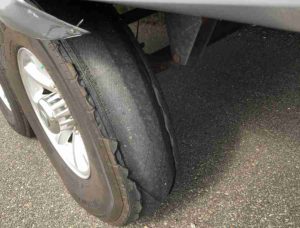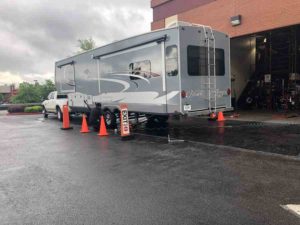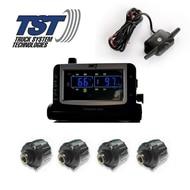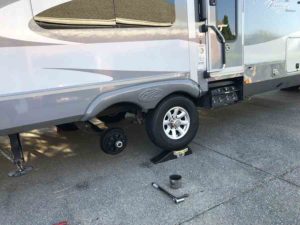Some Facts About Tire Monitoring Systems
We have heard hundreds of stories from RVers relating to tire failure. Some of the tire failures issues an RVer may encounter can be a minor nuisance and some failures can be catastrophic.
The problem is tire failure can occur without even knowing it. Whether you are in a larger motorhome or a smaller towable (or anything in between), tire failure is an issue that can affect all RVers. There are more social media posts out there telling stories of 5th wheels including me and even smaller tow-ables that have had a tire completely shredding the underside of the RV. I had no idea that it was occurring until someone pulled up alongside me and waved me down.
between), tire failure is an issue that can affect all RVers. There are more social media posts out there telling stories of 5th wheels including me and even smaller tow-ables that have had a tire completely shredding the underside of the RV. I had no idea that it was occurring until someone pulled up alongside me and waved me down.
Motorhomes towing a vehicle can experience blowouts on the tow car as well and not even realize it. These are real issues but are all issues that could be prevented by having the proper tire pressure monitoring system installed.
Tire pressure issues and heat issues around the tire are the leading indicators of future tire failure. If you can be warned of issues that are beginning to develop, then you will have time to get off the road and check out the problem. Plain and simple, having a proper tire pressure monitoring system for your RV is the number one item you can purchase to assist in ensuring a safe trip for you and your family.
My Story
The picture on the left and above is what was left of my RV’s rear driver’s side tire from a blowout just west of downtown Mobile, AL. A little background, they are Westlake Tires, 3 years old, original equipment with approximately 26,000 miles on them. I am an avid tire pressure checker prior to trips and I try to keep a close eye on them during stops. It was not a particularly hot day and my speed was around 65 to 70 miles an hour, the tires are rated for 75. We were not overweight and running about 700 lbs under our GVW.
As I mentioned above had it not been for an SUV pulling up beside me to let me know I just had a blowout I would have never know. The damage it caused was not catastrophic, thank god but it did cause some significant damage. You can read the complete details here: Blow Out
Needless to say the rest of the trip I was on pins and needles wondering which tire would go next. We managed to cover another 4,000 miles without incident. I was determined to replace those tires when I got back to home base. That TPMS starting looking very appealing to me so I started my research.
Tire Change
 After researching a number of Tires and speaking to other Open Range owners I landed on Goodyear G614 RST. I use Discount Tires for all my tire needs. They were able to match an online price I had found, so I was happy with the price and purchase.
After researching a number of Tires and speaking to other Open Range owners I landed on Goodyear G614 RST. I use Discount Tires for all my tire needs. They were able to match an online price I had found, so I was happy with the price and purchase.
I took the rig in and they got me in and out in under an hour. I was now feeling very confident that I have chosen the right tire, they were installed and pressured up properly life was good.
I still felt that I needed a Tire Monitoring System to complement this investment and give me the peace of mind I now felt we needed. I have in the past purchased most of my technical gear from Techno RV They typically have some great pricing and more importantly fantastic installation and informational videos. Thereafter sale follow-up and help is 5 star.
I settled on the TST Tire Pressure Monitoring Cap System. Here are the key features of this system:

- Programmable for up to 110 tires
- Easy-to-read COLOR monitor reports both psi and temperature simultaneously on the screen
- Pressure activated sensors
- Signal repeater included in all kits
- Monitor continuously scrolls through each tire in 5-second increments – no need to push buttons to see each tire’s reading as you drive
- The monitor can handle up to 4 different tow-ables or trailers
- The monitor will alarm with gradual pressure loss, rapid pressure loss, or elevated temperature
- GE circuitry in the monitor
- Double insulated sensors with theft-deterrent features included
- User-replaceable batteries (507 models) or 5-year battery (510 models)
- Cap sensor or flow-through sensor available (507 models)
- Weight of 507 sensors: Cap -13 g / 0.45 oz. Flow-Thru – 22 g / 0.77 oz.
- Weight of 510 sensors: 23 g / 0.81 oz.
- Sensor operation temperature: -40oF to 257oF
- Pressure Range: 0 to 218 psi
- Easy to program
- Signal Repeater is included with all kits
The Alarms Are Sounding!
Four days into the new tires, with about 50 miles on them I install the TST System. The installation was a breeze with the support documents and video that Techno supplies. I set the high and low inflation warnings, heat, etc. and all systems looked good. I now feel that we have the complete tire safety package and we are about to head out for our next trip in a few days.
I decided I would install the signal repeater to put a final touch on installation the next morning. Let’s turn on the monitor and check the signal and see what the tire pressures look like. Fire it up and the ALARMS start sounding on the monitor. How can that be I ask myself? I notice that one of the tires is down almost 18 lbs from the 95 lbs Goodyear recommends I run based on my weight. This is not good so I fill the tire again to its proper pressure and we will see what’s up in the am.
Surprise Surprise
I wake in the am and head out to the truck to turn on the monitor to check the pressures. This time ALARMS are sounding and I find all but the spare are losing pressure and one is down again by 19lbs. It was a bit cooler that morning so I decided that the other tires are just adjusting to a lower temp. The problem tire needs further inspection.
and one is down again by 19lbs. It was a bit cooler that morning so I decided that the other tires are just adjusting to a lower temp. The problem tire needs further inspection.
I pop it off using my trusty Trailer-Aid, you should invest in one as well and head to Discount Tires to get a diagnosis. The boys at Discount determine that the High-Pressure valves they installed are not seating properly. I chase down steel valves and bring the rig back around to have each of the tire pressure valves replaced with the new steel truck valves.
To say this could have been catastrophic is an understatement. We were about to head south to Augusta, GA via I-24. This takes us over MT. Eagle in TN with a rather steep grave on the other side of the climb. The potential for 4 flat tires made me cringe.
Moral Of The Story
Had I not had the TPMS I would not have identified this problem early. Yes, I would have checked the pressure of all the tires as I usually do the day we leave and filled them to the proper level. Off we would have headed to Augusta not knowing that we could experience 4 flat tires as we headed down that 8% grade of MT Eagle. Yikes!
Reach out to Evan at TechnoRV and they will send you all the information you need on this system. It has paid for itself based on the above-described incident. I’m sure it will continue to pay for itself as we travel over the next few years,
